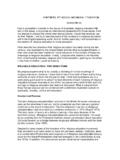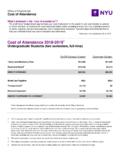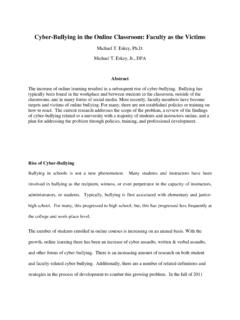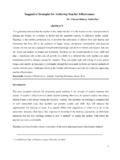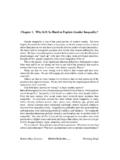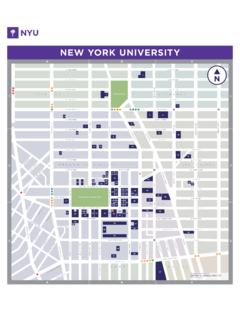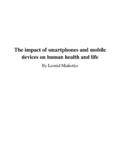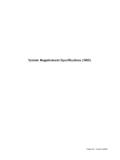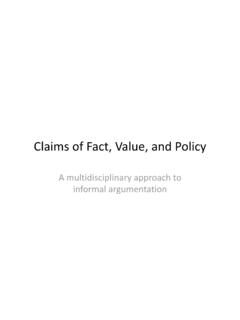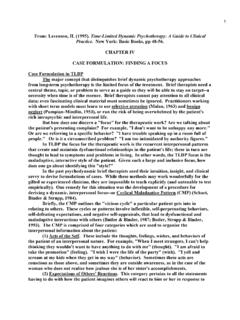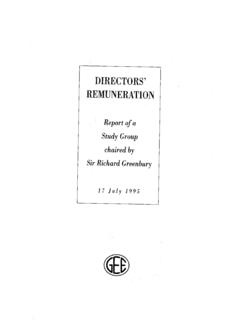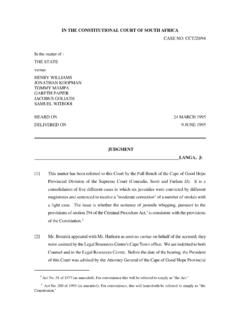Transcription of On a confusion about a function of consciousness - …
1 BEHAVIORAL AND BRAIN SCIENCES ( 1995 ) 18, 227-287 Printed in the United States of America On a confusion about a function of consciousness Ned Block Department of Unguistics and Philosophy, Massachusetts Institute of Technology, Cambridge, MA 02139 Electronic mall: Abstract: consciousness is a mongrel concept: there are a number of very different "consciousnesses." Phenomenal consciousness is experience; the phenomenally conscious aspect of a state is what it is like to be in that state. The mark of access- consciousness , by contrast, is availability for use in reasoning and rationally guiding speech and action. These concepts are often partly or totally conflated, with bad results. This target article uses as an example a form of reasoning about a function of" consciousness " based on the phenomenon ofblindsight. Some information about stimuli in the blind field is represented in the brains ofblindsight patients, as shown by their correct "guesses.
2 " They cannot harness this information in the service of action, however, and this is said to show that a function of phenomenal consciousness is somehow to enable information represented in the brain to guide action. But stimuli in the blind field are both access-unconscious and phenomenally unconscious. The fallacy is: an obvious function of the machinery of access- consciousness is illicitly transferred to phenomenal consciousness . Keywords: access; attention; awareness; blindsight; consciousness ; function ; retrieval 1. Introduction The concept of consciousness is a hybrid, or better, a mongrel concept: the word " consciousness " connotes a number of different concepts and denotes a number of different phenomena. We reason about " consciousness " using some premises that apply to one of the phenomena that fall under " consciousness ," other premises that apply to other "consciousnesses," and we end up with trouble. There are many parallels in the history of science.
3 Aris-totle used "velocity" sometimes to mean average velocity and sometimes to mean instantaneous velocity; his failure to see the distinction caused confusion (Kuhn 1964). The Florentine Experimenters of the seventeenth century used a single word (roughly translatable as "degree of heat") for temperature and for heat, generating para-doxes. For example, when they measured "degree of heat" by whether various heat sources could melt paraffin, heat source A came out hotter than B, but when they measured "degree of heat" by how much ice a heat source could melt in a given time, B was hotter than A (Wiser & Carey 1983). These are very different cases, but there is a similarity, one that they share with the case of" conscious-ness." The similarity is: very different concepts are treated as a single concept. I think we all have some tendency to make this mistake in the case of " consciousness ." Though the problem I am concerned with appears in many lines of thought about consciousness , it will be convenient to focus on one of them.
4 My main illustration of the kind of confusion I am talking about concerns reasoning about the function of consciousness . The issue of the function of consciousness is, in fact, more the platfonn of this article than its topic. Because the article attempts to expose a confusion , it is primarily concerned l!:l 1995 Cambridge University Press 0140-525X/95 $ +.10 with reasoning, not with data. Long stretches of text without data may make some readers uncomfortable, as will my fanciful thought-experiments. But if you are interested in consciousness , then if I am right you can't afford to lose patience. A stylistic matter: because this paper will have audiences with different concerns, I have adopted the practice of putting in footnotes items that will mainly be of technical interest to part of the audience. Footnotes can be skipped without losing the thread. I now turn to blindsight and its role in reasoning about a func-tion of consciousness .
5 Patients with damage in primary visual cortex typically have "blind" areas in their visual fields. If the experimen-ter flashes a stimulus in one of these blind areas and asks the patient wh~t he saw, the patient answers "nothing." The striking phenomenon is that some (but not all) of these patients are able to "guess" reliably about certain features of the stimulus, features having to do with mo-tion, location, direction ( , whether a grid is horizontal or vertical). In "guessing," they are able to discriminate some simple forms. If they are ask~d to grasp an object in the blind field (which they say they cannot see), they can shape their hands in a way appropriate to grasping it, and there are some signs of color discrimination. It is interest-ing that visual acuity (as measured, e. g., by how fine a grating can be detected) increases further from where the patient is looking in blindsight, the opposite of normal sight. (Blindsight was first noticed by Poppe!)
6 Et al., 1973; there is now a huge body of literature on this and related phenomena. See Bornstein & Pittman 1992; Milner & Rugg 1992.) [See also Campion et al.: "Is Blindsight an Effect of Scattered Light, Spared Cortex, and Near-threshold Vision?" BBS 6(3) 1983.] consciousness in some sense is apparently missing 227 Block: confusion about consciousness (though see McGinn, 1991, p. 112, for an argument to the contrary), and with it the ability to deploy information in reasoning and rational control of action. For example, Marcel (1986) observed that a thirsty blindsight patient would not reach for a glass of water in his blind field (one must grant Marcel some "poetic license" in this influential example; blindsight patients appear to have insufficient form perception in their blind fields to pick out a glass of water). It is tempting to argue (Barrs 1988; Flanagan 1991; 1992; Marcel 1986; 1988; van Gulick 1989) that because consciousness is missing in blindsight, consciousness must have a function of somehow enabling information represented in the brain to be used in reasoning, report-ing, and rationally guiding action.
7 I mean the "rationally" to exclude the "guessing" kind of guidance of action that blindsight patients are capable of in the case of stimuli presented to the blind field. The idea is that when a content is not conscious -as in the blindsight patient's blind field perceptual contents, it can influence behavior in various ways, but only when the content is conscious does it play a rational role; and so consciousness must be involved in promoting this rational role. A related argument is also tempting: van Gulick (1989) and Searle (1992) discuss Penfield's (1975) observations of epileptics who have a seizure while walking, driving, or playing the piano. The epileptics continue their activities in a routinized, mechanical way despite, it is said, a total lack of consciousness . Searle says that because conscious-ness as well as flexibility and creativity of behavior are missing, we can conclude that a function of consciousness is somehow to promote flexibility and creativity.
8 These two arguments are the springboard for this target article. Although some variants of this sort of reasoning have some merit, they are often given more weight than they de-serve, because of a persistent fallacy involving a conflation of two very different concepts of consciousness . The plan of the paper is as follows: in the following section I will briefly discuss some other syndromes much like blindsight, sketching one model that has been offered for explaining them. Then, in the longest part of the paper, I will distinguish the two concepts of consciousness whose conflation is the root of the fallacious arguments. Once that is done, I will sketch what is wrong with the target reasoning and also what is right about it, concluding with some remarks on how it is possible to investigate the function of consciousness empirically without having much of an idea about the scientific nature of con-sciousness. 2. Other syndromes and Schacter's model To introduce a second blindsight-like syndrome, I want first to explain a syndrome that is not like blindsight: prosopagnosia (prosop = face, agnosia = neurological deficit in recognizing).
9 Prosopagnosics are unable to rec-ognize visually their closest relatives - even pictures of themselves, though usually they have no trouble recog-nizing their friends by their voices or, according to anec-dotal reports, visually recognizing people by recognizing characteristic motions of their bodies. Although there is wide variation from case to case, prosopagnosia is compat-ible with a high degree of visual ability, even in tasks involving faces. 228 BEHAVIORAL AND BRAIN SCIENCES ( 1995 ) 18:2 One patient who has been studied by my colleagues in the Boston area is LH, a Harvard undergraduate who emerged from a car accident with very localized brain damage that left him unable to recognize even his mother. His girl friend began to wear a special ribbon so that he would know who she was. Now, years later, he still cannot identify his mother or his wife and children from photo-graphs (Etcoff et al. 1991). Still, if shown a photo and asked to choose another photo of the same person from a set of, say, five photos presented simultaneously with the original, LH can do almost as well as normal people despite differences between the target and matching photos in lighting, angle, and expression.
10 Now we are ready for the analog of blindsight. The phenomenon is exhibited in many experimental para-digms, but I will mention only this: it has recently been discovered (by Sergent & Poncet 1990) that some pro-sopagnosics are very good at "guessing" between two names in the same occupational category ("Reagan" and "Bush"") for a person whose face they claim is unfamiliar (see Young 1994a; 1994b; Young & de Haan 1993, for a description of these phenomenon). Interestingly, LH d_oes not appear to have "covert knowledge" of the people whose faces he sees, but he does appear to have "covert knowledge" of their facial expressions (Etcoff et al. 1992). Many such phenomena in brain-damaged patients have now been explored using the techniques of cognitive and physiological psychology. Further, there are a variety of phenomena that occur in normal people like you and me. For example, suppose that you are given a string of words and asked to count the vowels.
